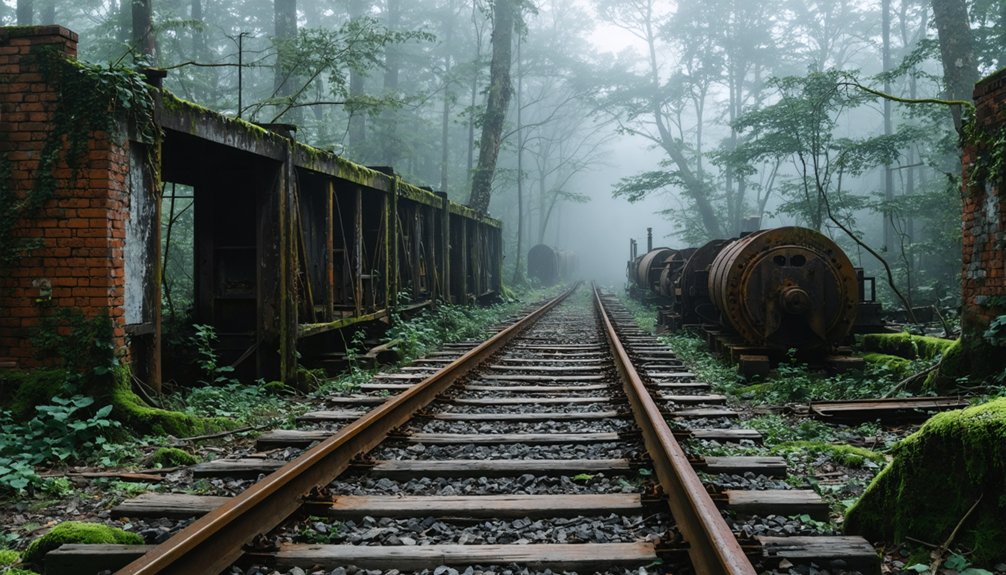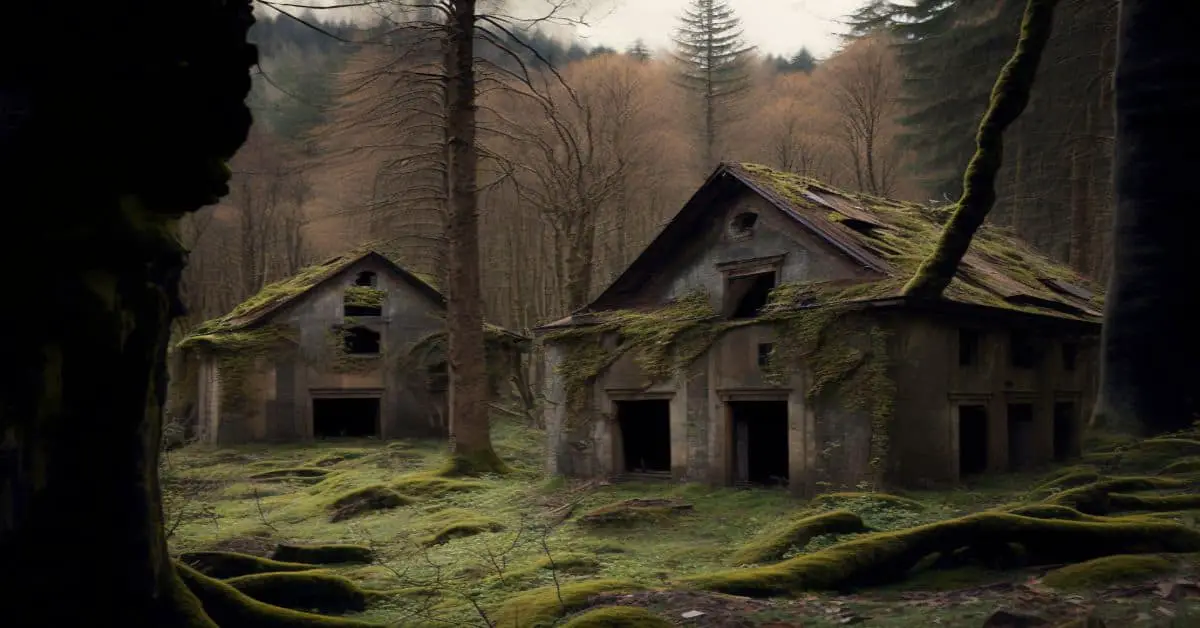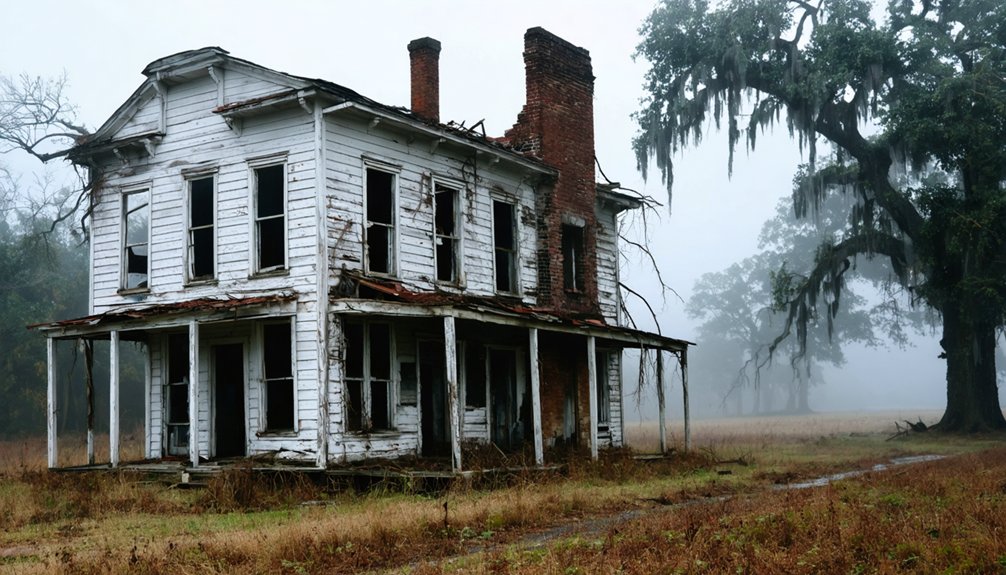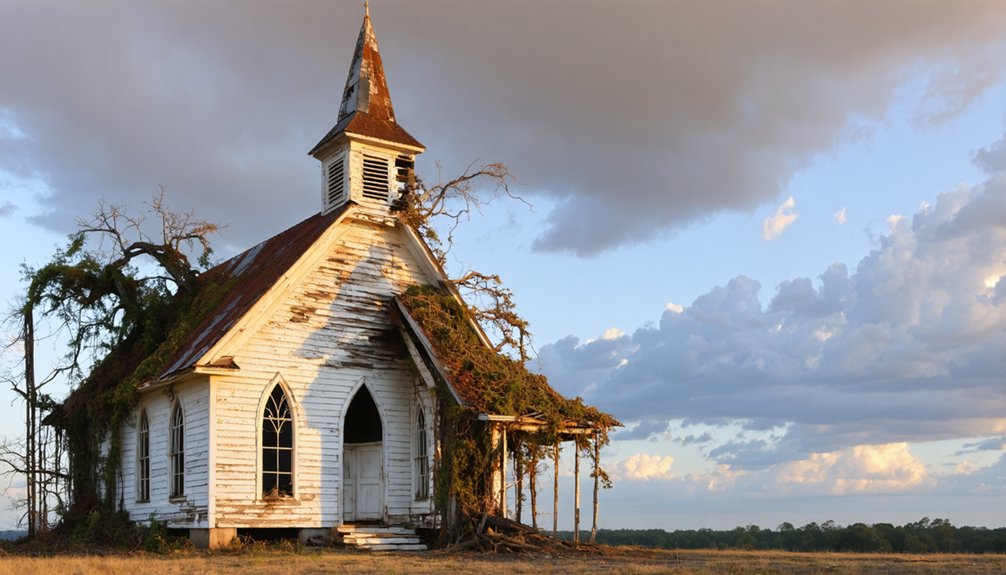You’ll find the haunting remains of Allatoona, Georgia beneath Lake Allatoona’s waters, where a bustling mining town once thrived. Before its flooding in 1949, this community survived gold fever, hosted a vital Civil War battle, and supported thousands of residents with its iron works and foundry. When water levels drop, you can still spot the ghostly foundations of Glen Holly and Cooper’s Furnace – silent witnesses to a rich history waiting to reveal its deeper secrets.
Key Takeaways
- Allatoona was a thriving mining and railroad town that now lies submerged beneath Lake Allatoona’s waters.
- The town once had 2,000 residents and featured prominent iron works before being flooded in 1949.
- Remnants of Glen Holly, part of historic Allatoona, become visible when lake water levels drop significantly.
- The U.S. Army Corps of Engineers’ dam project in 1946 led to the town’s submersion during lake creation.
- Over 1,000 historic sites from the original town remain preserved underwater, including structures from Civil War era.
The Rise and Fall of a Thriving Mining Village
While many Georgia ghost towns faded quietly into history, Allatoona’s story stands out as a dramatic tale of boom and bust in the American South.
From gold rush glory to Civil War ruin, Allatoona’s dramatic rise and fall echoes through Georgia’s forgotten places.
You’ll find its origins in the early settlers like John Clayton, who built wealth through agriculture before gold mining fever swept through the region. As prospectors traced gold veins from Lumpkin County, Allatoona transformed from a simple farming community into a bustling hub of mineral extraction. Early miners established mining tunnel networks throughout the area, digging them entirely by hand with basic tools.
The Western & Atlantic Railroad made it an essential transport center, while nearby ironworks turned the area into an industrial powerhouse. The town grew around the Allatoona post office, which served the community from 1838 to 1918.
But the Civil War brought devastating change – Confederate General Hood’s failed attack, Sherman’s destruction, and economic collapse shattered the town’s prosperity.
Beneath the Waters: The Story of Lake Allatoona’s Creation
In the decades following Allatoona’s decline, a new chapter would reshape the landscape forever. The U.S. Army Corps of Engineers began construction of the Allatoona Dam in 1946, leading to the lake formation that would submerge the remnants of the once-bustling mining village. By December 1949, the waters began rising, creating a massive 12,010-acre reservoir that forever changed the region’s destiny.
- The $31.5 million project transformed the Etowah River into a sprawling lake with a 145-foot maximum depth.
- Submerged communities and infrastructure gave way to a new purpose: flood control and power generation.
- The lake’s creation sparked unprecedented recreational development, including Georgia’s first African American state park.
The John Loyd Atkinson led efforts to establish George Washington Carver State Park along the lake’s shores in 1950.
– You’ll find 367,500 acre-feet of water where towns once stood, now drawing 7 million visitors annually to its shores.
The lake reached its record high level of 861.19 feet in April 1964, demonstrating the dramatic transformation of the valley.
Echoes of War: The Battle That Changed Everything
During the crisp autumn morning of October 5, 1864, the Battle of Allatoona Pass erupted as Confederate General Samuel French‘s 3,276 men launched an assault against Union forces commanded by Brigadier General John M. Corse.
The military strategy began with an intense artillery barrage at 7:00 A.M., as eleven Confederate Napoleon guns hammered the Union fortifications. After a two-hour bombardment and Corse’s refusal to surrender, French’s troops charged from the north and west. This fateful decision led to one million rations being left uncaptured in the railroad supply base.
The battle’s historical legacy is marked by one of the Civil War’s highest casualty rates at 30%. Though French withdrew by 2:00 P.M., the battle’s impact on Hood’s Nashville Campaign proved decisive. Today, visitors can explore the well-preserved trenches that stand as silent witnesses to this pivotal conflict.
With a staggering 30% casualty rate, Allatoona Pass’s brutal toll shaped the outcome of Hood’s Nashville Campaign.
You can still walk these hallowed grounds today, exploring the preserved earthworks where soldiers once fought to shape America’s destiny.
Haunting Tales From the Submerged Town
Beneath Lake Allatoona‘s placid waters lies a town with tales as deep as the reservoir itself.
While ghostly legends swirl around this submerged settlement, you’ll find that documented spectral sightings are remarkably rare. One credible account from the 1870s tells of a phantom soldier spotted by a W&A Railroad conductor at Allatoona Pass, vanishing mysteriously into the fog. The evidence-based approach used by Lisa Russell helps separate fact from folklore in these ghostly tales. The once-bustling town of 2,000 residents featured an impressive iron works and foundry before its fateful flooding.
- When water levels drop, you can glimpse the haunting foundations of Glen Holly emerging from the depths.
- Over 280 drownings have occurred since the 1940s, though none with supernatural links.
- Only one verified ghost story exists: the Civil War soldier seen atop a train car.
- The lake’s violent history stems from both the Battle of Allatoona Pass and the town’s forced submersion.
Today, the ghostly reputation persists, though formal paranormal investigations remain conspicuously absent.
Hidden History: Archaeological Discoveries and Visible Remains
While ghostly legends may haunt Lake Allatoona’s waters, the area’s true mysteries lie in its rich archaeological record. Beneath the lake’s surface, you’ll find over 1,000 historic and prehistoric sites, including the remarkable Wilbanks Site, a representation of the Late Mississippian culture‘s presence. The area’s flooding in the 1940s for hydropower transformed this historically significant landscape forever.
Archaeological findings reveal a fascinating timeline of human activity, from ancient Archaic hunters to the sophisticated Woodland and Mississippian societies. The site’s discoveries include a prominent 220-foot diameter mound that dominated the landscape during its peak occupation.
You can still spot Cooper’s Furnace monument, marking the vanished town of Etowah, but countless other treasures remain hidden underwater. The submerged landscape holds prehistoric fish traps, ancient pottery fragments, and remnants of a once-thriving 19th-century mining town.
These artifacts paint a vivid picture of the area’s cultural significance, from its earliest Native American settlements through the Georgia Gold Rush era.
Frequently Asked Questions
Can Visitors Scuba Dive to Explore the Submerged Ruins of Allatoona?
You can scuba dive to explore Allatoona’s submerged ruins, but you’ll need experience and proper equipment. Visibility’s best in late summer, reaching 10 feet near the dam area. Check local regulations first.
What Happened to the Graves and Cemeteries When the Town Was Flooded?
Most graves were carefully relocated to higher ground through grave relocation efforts, with cemetery preservation teams working to move remains and headstones before the flooding. You’ll find many reinterred in nearby cemeteries.
Are There Any Surviving Former Residents of Old Allatoona Still Alive Today?
You won’t find any confirmed surviving residents from old Allatoona today. While local legends mention some surviving families scattered across Georgia, historical records don’t verify any living connections to the original town.
How Much Gold Was Actually Mined From Allatoona Before the Civil War?
You’d love to know the exact gold extraction figures, wouldn’t you? Unfortunately, there aren’t any reliable records of Allatoona’s total gold output, despite the various mining techniques used before 1860.
Does the Army Corps of Engineers Ever Plan to Drain the Lake?
You won’t see the Corps draining Allatoona Lake – their lake management plan focuses on water supply, flood control, and recreation. Historical preservation exists through maintaining, not removing, this essential reservoir.
References
- https://yesterdaysamerica.com/history-submerged-georgias-drowned-towns/
- https://lisamrussell.net/the-haunting-of-allatoona-pass/
- https://driftwoodchronicle.wordpress.com/2016/10/11/gone-with-the-wind-ghost-towns-of-georgia/
- https://www.southernspiritguide.org/apparitions-at-allatoona-cartersville-georgia/
- https://myfamilytravels.com/abandoned-georgia-parks-with-haunting-histories/
- https://lisamrussell.net/category/microhistory/
- http://avagabonde.blogspot.com/2013/11/hiking-on-historic-allatoona-pass-trail.html
- https://www.youtube.com/watch?v=dBYHqt2CSW4
- https://evhsonline.org/bartow-history/places/allatoona
- https://evhsonline.org/archives/47935



